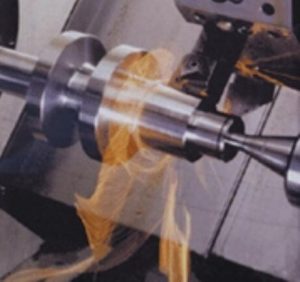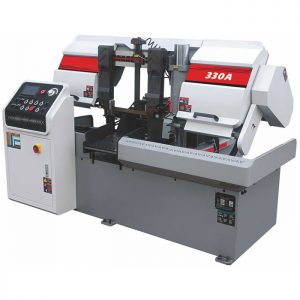Hard turning clean material for lathe and its selection

Coated carbide
Coated carbide cutting tools are coated with one or more layers of TiN, TiCN, TiAlN and Al2O3 with good wear resistance on the tough carbide cutting tools. The thickness of the coating is 2~18µm. The layer usually plays the following two roles: on the one hand, it has a much lower thermal conductivity than the tool base and workpiece material, which weakens the thermal effect of the tool base; on the other hand, it can effectively improve the friction and the cutting process. Adhesion, reducing the generation of cutting heat. Compared with cemented carbide cutting tools, coated carbide cutting tools have been greatly improved in terms of strength, hardness and wear resistance. For the turning of workpieces with dry hardness between HRC45 and 55HRC, low-cost coated carbide can realize high-speed turning. In recent years, some manufacturers have greatly improved the performance of coated tools by improving the coating materials and proportions. For example, some manufacturers in the United States and Japan use Swiss AlTiN coating materials and new coating ed technology to produce inserts with a hardness of up to 4500-4900HV. When the turning temperature is as high as 1500℃-1600℃, the hardness still does not decrease, and it does not oxidize, and the blade life is average. 4 times the coated blade. The cost is only 30%, and the adhesion is good. It can process die steel with hardness of 47-52HRC at a speed of 498.56m/min.
Ceramic material
Ceramic cutting tools have the characteristics of high hardness (91~95HRA), high strength (bending strength of 750~1000 MPa), good wear resistance, good chemical stability, good anti-bonding performance, low friction coefficient and low price. In normal use, the durability is extremely high, and the speed can be increased by 2 to 5 times compared with cemented carbide. It is especially suitable for high-hardness material processing, finishing and high-speed machining. It can process all kinds of hardened steel and hardened cast iron with a hardness of 62HRC. Commonly used are alumina-based ceramics, silicon nitride-based ceramics, cermets and whisker-toughened ceramics. In recent years, through a lot of research, improvement and the use of new production processes, the bending strength and toughness of ceramic materials have been greatly improved. The developed new CT series of cermet blades and coated cermet blade series, the diameter of the grain structure is as small as 1µm, and the bending strength and wear resistance are much higher than ordinary cermets, which greatly broadens the ceramic material. scope of application. The silicon nitride ceramic material tool successfully developed by Tsinghua University has also reached the international advanced level.
CBN
The hardness and wear resistance of CBN are second only to diamond, and it has excellent high temperature hardness. Compared with ceramic tools, its heat resistance and chemical stability are slightly worse, but its impact strength and crush resistance are better. It is widely used in the cutting of hardened steel (above 50HRC), pearlitic gray cast iron, chilled cast iron and superalloy, etc. Compared with cemented carbide tools, its cutting speed can even be increased by an order of magnitude.
PCBN tools with high CBN content have high hardness, good wear resistance, high compressive strength and good impact toughness, but their disadvantages are poor thermal stability and low chemical inertia, suitable for cutting heat-resistant alloys, cast iron and iron-based sintered metals processing. The content of CBN particles in the composite PCBN tool is low, and the ceramic is used as the binder, which has low hardness, but makes up for the poor thermal stability and low chemical inertness of the former material, and is suitable for cutting hardened steel.
In applications for cutting grey cast iron and hardened steel, both ceramic and CBN tools are available, so a cost-benefit and machining quality analysis is necessary to determine which material is more economical. The cutting performance of PCBN tool materials is better than that of Al2O3, and when dry machining of Si3N4 hardened steel, the cost of Al2O3 ceramics is lower than that of PCBN materials. Ceramic tools have good thermochemical stability, but they are not as tough and hard as PCBN tools. When cutting workpieces with hardness below 6OHRC and small feed rates, ceramic tools are a better choice. PCBN tools are suitable for workpiece hardness higher than 60HRC, which is especially important for automated processing and high-precision processing. In addition, under the same flank wear condition, the residual stress on the workpiece surface after cutting by the PCBN tool is also relatively stable than that of the ceramic tool.
Dry cutting of hardened steel with PCBN tools should also follow the following principles: choose a large depth of cut as far as the rigidity of the machine tool allows, so that the heat generated in the cutting area can locally soften the metal in the front edge area, which can effectively reduce the wear of the PCBN tool. In addition, PCBN tools should be used as much as possible in small cutting probes. Due to the poor thermal conductivity of PcBN tools, the heat in the cutting area cannot be diffused in time, and the shearing area can also produce obvious metal softening effect, reducing the wear of the cutting edge.
Blade structure and geometry are determined by reference
Reasonable determination of insert shape and geometric parameters is crucial to give full play to the cutting performance of the tool. In terms of tool strength, the tip strengths of various blade shapes from high to low are: round, 100° rhombus, square, 80° rhombus, triangle, 55° rhombus, and 35° rhombus. After the blade material is selected, the blade shape with high strength should be selected as much as possible. Hard turning inserts should also choose the largest tool nose arc radius as possible, and use round and large radius inserts for rough machining. The tool nose radius during finishing is about 0.8 ~ 1.2µm.
The hardened steel chips are red and soft forged strips, which are brittle, easy to break, and do not stick. Generally, there is no built-up edge on the cutting surface, and the processed surface quality is high, but the cutting force of hardened steel is relatively large, especially The radial cutting force is larger than the main cutting force, so the tool should adopt a negative rake angle (go≥-5°) and a larger clearance angle (ao=10°~15°). The entering angle depends on the rigidity of the machine tool. Generally take 45 ° ~ 60 ° to reduce workpiece and tool chatter.
Selection of cutting parameters
The higher the hardness of the workpiece material, the smaller the cutting speed should be. The suitable cutting speed for hard turning finishing is 80-200m/min, and the common range is 10-150m/min. When large depth of cut or strong interrupted work are used to cut high-hardness materials, the cutting speed should be maintained at 80-100m/min. In general, the depth of cut is 0.1 to 0.3 mm. When the machining surface roughness is required to be high, a small cutting probe can be selected, but it should not be too small and should be suitable. The feed rate can usually be selected from 0.05 to 0.25mm/r, and the specific value depends on the surface roughness value and productivity requirements. When the surface roughness is Ra0.3~0.6µm, hard turning is more economical than grinding.
Requirements for the process system
In addition to selecting reasonable tools, hard turning has no special requirements for lathes or turning centers. If the rigidity of the lathe or turning center is sufficient, and the required accuracy and surface roughness can be obtained when machining soft workpieces, it can be used for hardened steel. processing. In order to ensure a smooth and continuous turning operation, the usual method is to use a rigid clamping device and a medium rake angle tool. However, it is generally believed that hard turning requires a high-rigidity lathe, that is, the key to hard turning is that the machine tool has sufficient rigidity, and the tool, workpiece, and clamping device are compact and have the same rigidity. Existing equipment can be used for hard turning if the workpiece can be positioned, supported and rotated fairly smoothly under cutting forces.



